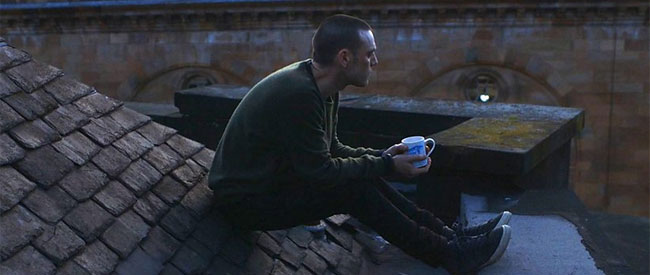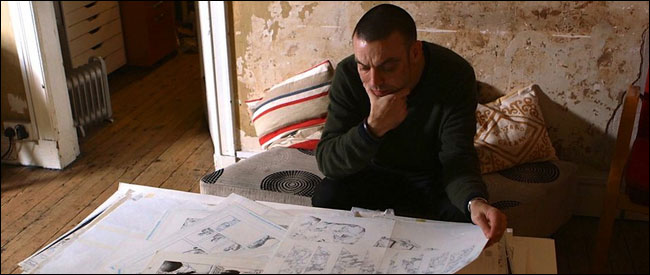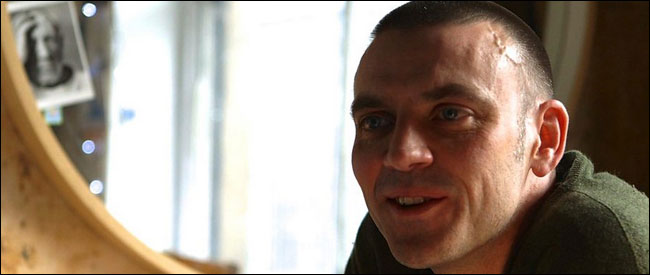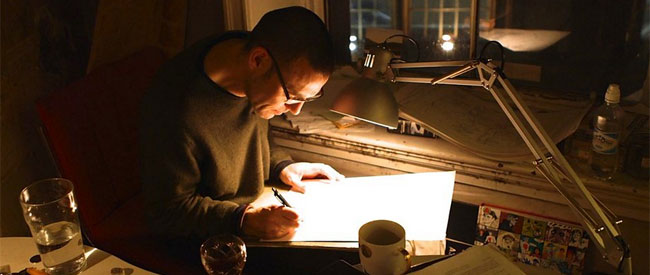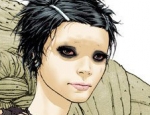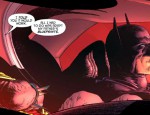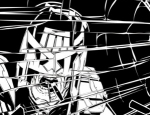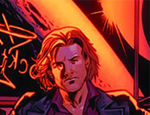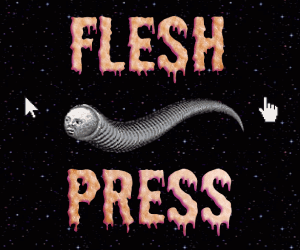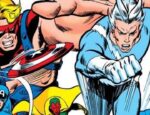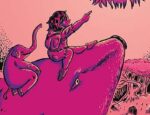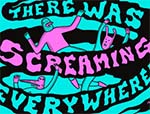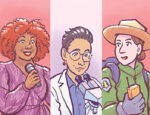In an exclusive interview, we chat to comics fan and film-maker Joseph Briffa, director of the BBC’s What Do Artists Do All Day? documentary on superstar artist Frank Quitely.
Comics readers can be a pessimistic lot, and a lot of us might not have been expecting great things when we heard that a BBC documentary was going to look at a day in the life of fan-favourite artist Frank Quitely (real name Vincent Deighan). After all, we’ve had enough superimposed POWs and ZAPs to last a lifetime.
However, the film itself – shown on BBC Scotland a couple of weeks ago and being repeated nationwide on BBC Four on Tuesday March 18 – was a thoughtful and well-made look at the dedicated, almost monastic life of the artist, which also made a good case for the narrative magic that comics can conjure up.
In a Broken Frontier exclusive, we talked to director Joseph Briffa about the film, working with Frank Quitely, his own thoughts on the world of comics – and the identity of the other comics mega-star who rang out of the blue for a chat…
First off, Joseph, can you give us a bit of background on yourself?
I’m from Newcastle, but moved to Glasgow in the late ’90s to study painting at the Glasgow School of Art. When I left I got a bit of work doing storyboards for ads and then found myself drifting into film making, both drama and documentary.
I made short films (winning a BAFTA Scotland for my first short, Six Hours of Daylight), corporate stuff and films for museums, and recently I’ve been making ads and TV documentaries.
How did the opportunity to make the film come about?
I knew they were making the What Do Artists Do All Day? series out of BBC Scotland, so managed to get a meeting where I suggested doing one on Frank.
Why/how did you end up with Frank Quitely as a subject?
I didn’t know this, but they were looking to widen the types of artists they were featuring, beyond what you’d normally call contemporary fine artists.
I hadn’t met Frank, but knew he was based here in Glasgow and had heard his studio was a pretty interesting place. And in terms of profile, cultural importance, the collaborations he gets involved in and ultimately the sheer artistry of his work, I think it was a pretty easy sell.
Were you familiar with Frank’s work before making the film?
Yeah, mostly through We3 and All-Star Superman. We3 in particular just amazed me when it came out. The storytelling’s so strong and it’s such a clever, coherent book. It’s Pure Comics in that the storytelling and visual design are utterly inter-reliant. I’ve read it over and over again, and it rewards in a new way each time.
What other comics are you into?
At the moment I’m really enjoying Locke and Key, Saga and Fables. Also the work of Seth and Chris Ware; I’m into the whole “books as objects” thing and they’re so well put together, but they’re also beautifully told stories.
I love EC comics, so am working my way through those re-coloured hardback editions.
Have you ever done any comics yourself?
I tried when I first left art school, but I couldn’t handle it. It’s an obvious thing to say, but it’s such hard work to get any good at it.
It’s such a particular discipline and it’s not just about being a half-decent drawer – it’s about storytelling and everything else. I think the film shows that a bit – it’s a massive commitment, even for people who are incredibly talented.
Did Frank take much convincing to take part? Did he have any misgivings?
He did. He wanted to help, but he could see it being a problem as he’s so up against it deadline-wise and it was bound to be disruptive in some way. He’s also a genuinely modest guy who just loves what he does and happens to be very good at it. I don’t really think he seeks attention or wants it really, and wouldn’t want to be seen as putting himself up there.
Did you call him Frank or Vincent?
Vin actually, but I slipped up more than a few times.
Did anything about his work practice or lifestyle surprise you?
In terms of process, I kind of knew how he works and it makes sense to me that he’d do extremely detailed digital drawings and then print these out to do the final line work by hand. His work isn’t inked, so in a way his pencilling is him actually inking. It’s the final line. I know a few people were surprised at the apparent duplication of work here, but I think it makes sense.
I wasn’t quite prepared for how hard he works. He obviously doesn’t do that all the time (I just made sure we’d arranged to film when he would be!) but that has to take its toll. I think he’s just incapable of leaving it if he’s not satisfied. I guess there are some people who would have more of a just bash-it-out sort of mentality.
I do think there’s a question, and this is between the lines a bit in the film, about what value we put on our comic artists. If he was working in a more universally recognised medium, if he was a contemporary visual artist or a novelist, he would be much much better remunerated for his work and no one would take issue with that.
If he worked for Hollywood (and let’s face it, he sort of does, but in a completely uncredited, unrecognised way), the same would apply. It was naive of me a bit but it did surprise me that someone so influential, who’s at the top of his profession and pretty much universally feted, still isn’t totally financially secure.
Were you worried about how to make the still pages of comics interesting on TV?
Yeah, and I never fully resolved it. Firstly, I don’t really like motion comics. I think what’s designed to be static on the page should just stay on the page it’s been designed to live on. The minute you start putting parallax shifts and energy crackles over things it looks cheap and nasty, and it ruins the original design intention of the artist; the composition of the panel and the page dynamic.
If it’s designed to be that way from the start – like the for-tablet stuff that people like Madefire are doing – then that’s great, but I hate seeing people’s work ‘brought to life’; it doesn’t need to be brought to life.
But having said that, the pages do look so static on screen – they just don’t sit naturally alongside filmed material for some reason. So against my principles, I opted for a tiny, tiny bit of movement on the pages and ended up playing with the panels a bit in the CCTV sequence from We3.
But I regret I never really felt I’d found a satisfying way of integrating the two without messing up the art, which, after all, is the whole point of the programme. It’s a dilemma.
How has the reaction been from comics fans? Was that something you were worried about?
I think it’s been good, from what I’ve seen from snooping around on the interweb. It was something I was really worried about as I’ve seen comics handled really badly on telly many times over the years and it always frustrated me as a fan.
You know, someone might get the opportunity to interview Alan Moore and it seems they don’t really ask him what they should be and then they insult all involved by putting a posterise effect on him to make it look like a comic, and plaster phoney comic sans captions all over the place. You know, stupid superhero music and a jokey voiceover. Just horrible, embarrassing stuff.
At the same time though, I had to remember we were making this for a general audience – an audience probably interested in art but maybe not familiar with comics, and certainly not with the specifics of Vin’s projects.
So it needed to be accessible while still being truthful and not at all glib. I have to say, the BBC were very interested in treating comic art as the nuanced, intelligent medium it is.
Might you be working on any more comics-related films or What Do Artists Do All Day?
I don’t know. It depends how this is received and whether they felt another artist could offer something new in terms of their working life and perspective. There were some concerns before we filmed about the inherently sedentary nature of drawing comics and how exciting this would be to actually watch, and I think there’s some validity to that.
If you could spend a day with any other comics creator – past or present – who would it be?
Obvious Artists From the Crypt who would fascinate would be Kirby when at Marvel and Hergé; I’d love to have seen his studio – a very different set up to Frank’s, I think. And it would’ve been great to be kicking about the EC offices in the 50s… imagine being a fly on the wall when Seduction of the Innocent broke!
Among actual living artists, I guess Chris Ware would have a lot to talk about, and my all-time favourite artist, Brendan McCarthy. I just used to stare and stare at his pages in 2000AD, and I always imagined he spent his days in quite interesting ways.
What are you working on now?
I have a few projects hopefully kicking off soonish, but wouldn’t want to jinx them by talking about them here. One documentary project is comic-history-related.
And finally… tell us a secret about Frank Quitely that didn’t make it into the film!
When I was there once the great Geof Darrow just phoned him up totally out of the blue to tell him how much he loved his work! I think they’ve quite a bit in common in terms of their commitment to their craft.
And there was loads of stuff we talked about that didn’t make it into the final 30 minutes. We covered his whole career in detail – Dredd, X-Men, Batman – so there were lots of nice little stories and moments. And lots about particular techniques and examples that we couldn’t put in due to time constraints. Maybe I should do a longer version one day…
Do it!
Huge thanks to Joseph for answering our questions, and thanks to him and Vin/Frank for making such a rewarding and enjoyable film.
Joseph’s episode of What Do Artists Do All Day? will be shown on BBC Four on Tuesday March 18 (22.50) and Wednesday March 19 (02.20), and will presumably be back on the BBC iPlayer again for a week after that.
For non-UK residents, I’m sure it won’t be long before some resourceful bod ‘liberates’ it and makes it more widely available.





